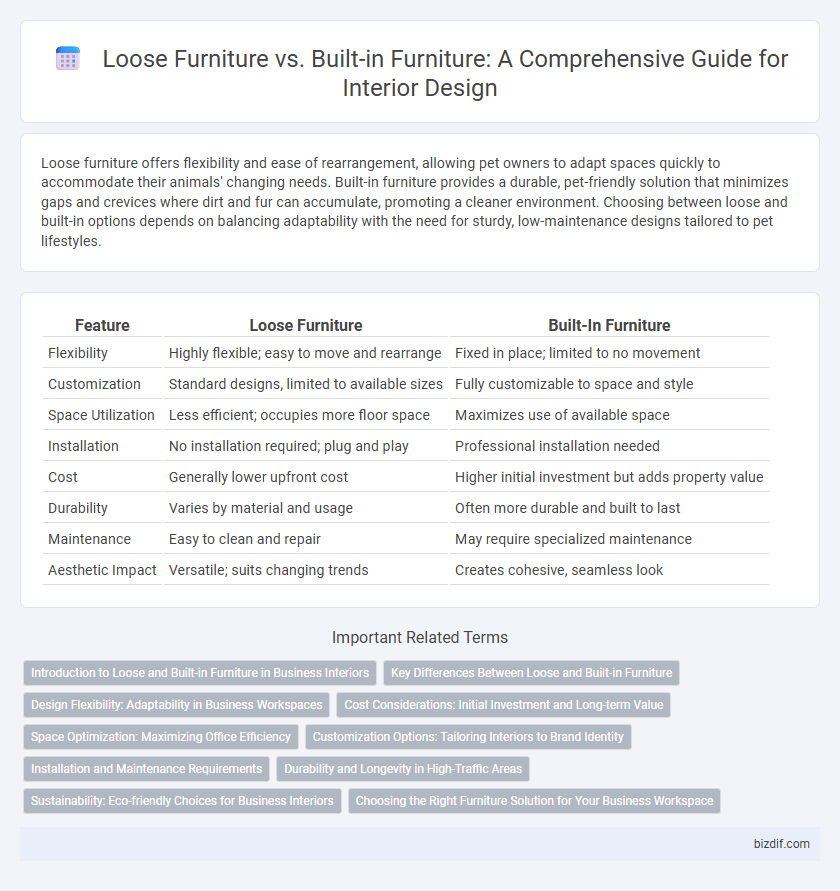Loose furniture offers flexibility and ease of rearrangement, allowing pet owners to adapt spaces quickly to accommodate their animals' changing needs. Built-in furniture provides a durable, pet-friendly solution that minimizes gaps and crevices where dirt and fur can accumulate, promoting a cleaner environment. Choosing between loose and built-in options depends on balancing adaptability with the need for sturdy, low-maintenance designs tailored to pet lifestyles.
Table of Comparison
| Feature | Loose Furniture | Built-In Furniture |
|---|---|---|
| Flexibility | Highly flexible; easy to move and rearrange | Fixed in place; limited to no movement |
| Customization | Standard designs, limited to available sizes | Fully customizable to space and style |
| Space Utilization | Less efficient; occupies more floor space | Maximizes use of available space |
| Installation | No installation required; plug and play | Professional installation needed |
| Cost | Generally lower upfront cost | Higher initial investment but adds property value |
| Durability | Varies by material and usage | Often more durable and built to last |
| Maintenance | Easy to clean and repair | May require specialized maintenance |
| Aesthetic Impact | Versatile; suits changing trends | Creates cohesive, seamless look |
Introduction to Loose and Built-in Furniture in Business Interiors
Loose furniture offers flexibility and easy rearrangement, ideal for dynamic business environments requiring adaptability. Built-in furniture provides custom design solutions, maximizing space efficiency and creating a seamless, integrated look in corporate interiors. Selecting between loose and built-in furniture depends on the business's functional needs, aesthetic goals, and long-term space planning.
Key Differences Between Loose and Built-in Furniture
Loose furniture offers flexibility and mobility, allowing homeowners to easily rearrange or replace pieces to suit changing tastes and room functions. Built-in furniture, anchored into walls or floors, maximizes space utilization and provides a seamless, custom look with enhanced durability and storage options. Key differences include the adaptability of loose furniture versus the permanence and tailored fit of built-in designs, impacting interior layout and maintenance considerations.
Design Flexibility: Adaptability in Business Workspaces
Loose furniture offers superior design flexibility, allowing businesses to easily rearrange or replace pieces to accommodate evolving workspace needs and team dynamics. Built-in furniture, while providing a cohesive and tailored aesthetic, limits adaptability and may require significant effort and cost to modify. Prioritizing loose furniture supports agile office environments by enabling customizable layouts that foster collaboration and productivity.
Cost Considerations: Initial Investment and Long-term Value
Loose furniture offers lower initial investment due to mass production and easy sourcing, making it cost-effective for budget-conscious projects. Built-in furniture requires higher upfront costs because of custom design, materials, and installation but delivers superior long-term value through increased durability, space optimization, and potential property value enhancement. Evaluating both options involves balancing immediate budget constraints against future resale appreciation and maintenance savings.
Space Optimization: Maximizing Office Efficiency
Loose furniture offers flexibility in office layouts, allowing easy rearrangement to adapt to changing workspace needs and optimize space utilization. Built-in furniture maximizes space efficiency by utilizing walls and corners, providing customized storage and workstations that reduce clutter and enhance workflow. Combining both options strategically can create a dynamic office environment that supports productivity and effective space management.
Customization Options: Tailoring Interiors to Brand Identity
Loose furniture offers extensive customization options, enabling businesses to select styles, colors, and materials that precisely reflect their brand identity and adapt easily to evolving interior design trends. Built-in furniture provides a seamless, integrated aesthetic with opportunities for bespoke craftsmanship tailored to unique spatial layouts and brand specifications, enhancing exclusivity and coherence. Prioritizing customization in both furniture types ensures interiors resonate with brand values while optimizing functionality and customer experience.
Installation and Maintenance Requirements
Loose furniture offers easy installation with minimal tools required, allowing for flexible room arrangements and straightforward cleaning. Built-in furniture demands professional installation, involving precise measurements and construction work, which can increase setup time and complexity. Maintenance for built-in units often requires specialized repairs, while loose furniture allows for simple upkeep and easy replacement of damaged pieces.
Durability and Longevity in High-Traffic Areas
Loose furniture offers flexibility but may wear out faster in high-traffic areas due to frequent movement and less integrated construction. Built-in furniture, crafted from durable materials and securely anchored, provides enhanced longevity, resisting wear and tear over time. For spaces with heavy use, built-in solutions ensure sustained durability and minimal maintenance.
Sustainability: Eco-friendly Choices for Business Interiors
Loose furniture allows for easy recycling and repurposing, reducing waste in business interiors and promoting circular economy principles. Built-in furniture often uses durable materials and minimizes frequent replacements, lowering resource consumption over time. Choosing sustainably sourced materials for either option enhances eco-friendly practices and supports green building certifications.
Choosing the Right Furniture Solution for Your Business Workspace
Loose furniture offers flexibility and easy reconfiguration, ideal for dynamic business workspaces that require adaptability for meetings, collaborations, and future growth. Built-in furniture maximizes space efficiency and provides a seamless, customized aesthetic, making it suitable for businesses seeking a cohesive and permanent design solution. Evaluating workspace layout, usage patterns, and long-term operational goals helps determine whether loose or built-in furniture best supports productivity and brand identity.
Loose furniture vs Built-in furniture Infographic

 bizdif.com
bizdif.com